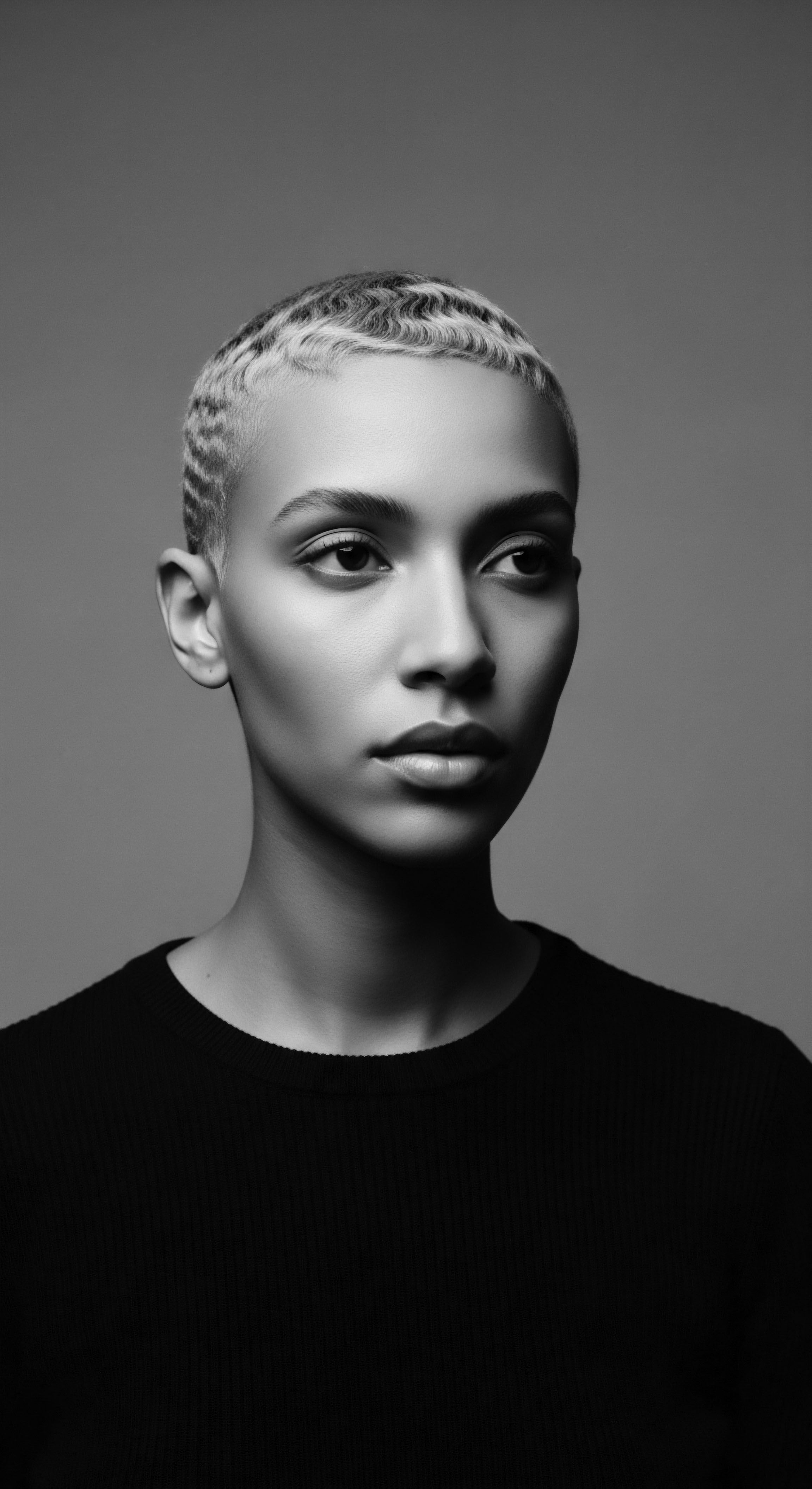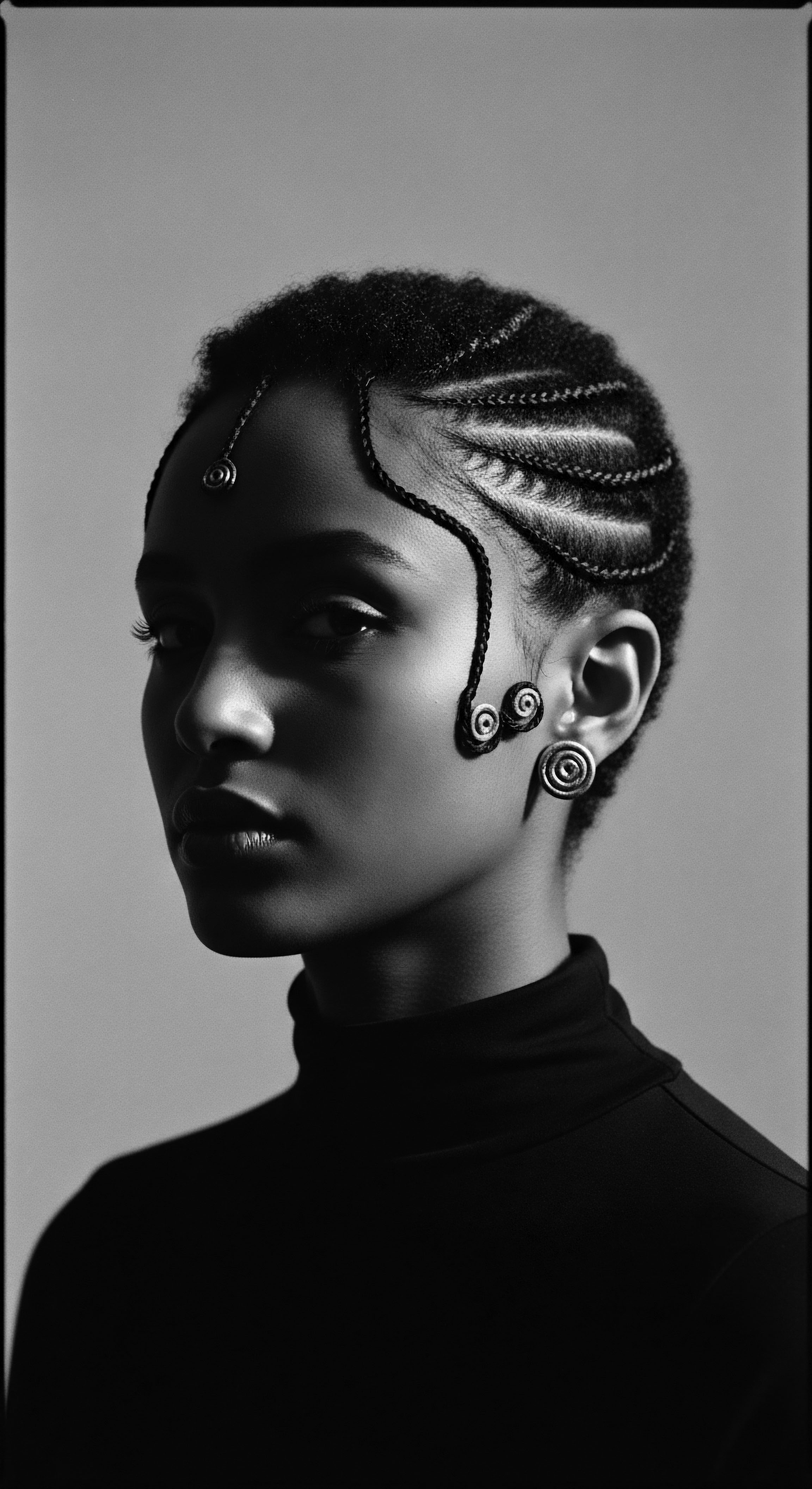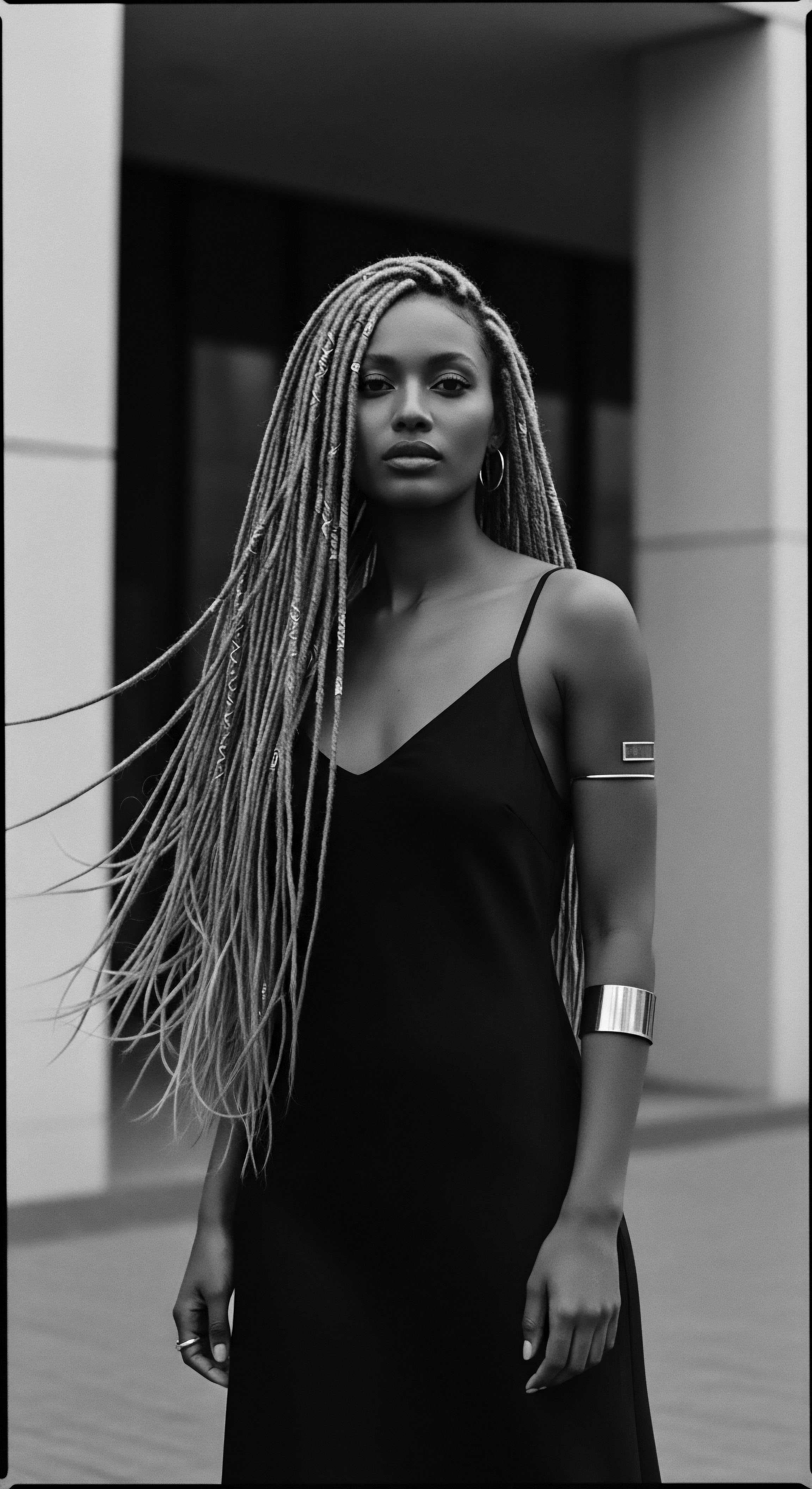
Roots
The story of hair, particularly hair that coils and curves, is written not merely in strands, but in the enduring spirit of communities across millennia. For those with textured tresses, this story carries a unique weight, a whispered lineage that reaches back through ancestral plains and across vast oceans. It is a chronicle of observation, adaptation, and an intimate connection to the very fabric of existence.
Our modern scientific understanding of hair’s architecture, its resilience, and its needs, often echoes the quiet wisdom gathered through generations of living, breathing care. The knowledge we now quantify in laboratories was once held in practiced hands, passed from elder to child, ingrained in daily rites.
Consider the individual strand, seemingly simple, yet a marvel of biological engineering. Textured hair, with its characteristic ellipticity and varied curl patterns, presents distinct challenges and qualities. Its shape influences how natural oils travel down the shaft, often leading to drier ends, a reality recognized by ancient caretakers who instinctively focused on moisturizing from root to tip.
The cuticle, that protective outer layer, lifts more readily on a curve, making textured hair susceptible to tangling and breakage if not handled with profound gentleness. This elemental biology, observed without microscopes, guided ancestral solutions for longevity and health.
Ancient observations of hair’s elemental biology shaped foundational care, revealing a profound, inherited wisdom concerning its unique needs.

Ancestral Hair Anatomy Understanding
Before advanced microscopy, observation was the primary scientific tool. Ancestral communities understood hair’s tendencies through repeated interaction. They noticed how certain environments made hair brittle, how particular plant concoctions brought softness, or how braiding could preserve length. This accumulated experiential knowledge, while not codified with modern scientific terms, formed a sophisticated practical understanding of hair’s physiology.
- Botanical Remedies ❉ Many traditional practices relied on the local flora, extracting oils, butters, and infusions. For example, shea butter, derived from the African shea tree, was a staple across West Africa, valued for its ability to seal moisture and soften curls. Its rich lipid profile, now understood scientifically, mimics the scalp’s natural sebum, offering protection that modern science seeks to replicate with emollients.
- Mineral Treatments ❉ Clays and specific earths were employed for cleansing or strengthening. These natural materials often contain minerals that could absorb excess oils, clarify the scalp, or even impart subtle color, reflecting an early form of cosmetic chemistry.
- Animal-Derived Products ❉ Certain animal fats or proteins were also used, offering conditioning properties, their efficacy rooted in their compatibility with hair’s keratin structure, a principle now applied in protein treatments.

How Did Early Classifications Influence Care?
Modern textured hair classification systems, like those using numbers and letters (3a, 4c), seek to categorize curl patterns scientifically. Yet, long before such systems, communities across Africa and the diaspora possessed their own nuanced ways of describing hair. These distinctions often went beyond mere curl shape, extending to texture, density, and even how hair responded to moisture, linking directly to care.
For instance, some traditional classifications might distinguish hair by its ability to hold a braid, its softness after washing, or its resistance to humidity, leading to specific, tailored care regimens within a household or community. Such classifications were embedded in cultural narratives, guiding practical application rather than being abstract scientific constructs.
| Historical Hair Care Principle Regular oiling and butter application to strands. |
| Modern Scientific Link Emollient Action ❉ Lipids and fatty acids coat the hair, reducing friction, sealing the cuticle, and preventing moisture loss, especially relevant for textured hair's propensity for dryness. |
| Historical Hair Care Principle Braiding and protective styling for longevity. |
| Modern Scientific Link Reduced Mechanical Stress ❉ Minimizes daily manipulation, preventing breakage from combing, styling, and environmental exposure, allowing for length retention. |
| Historical Hair Care Principle Use of plant-based cleansers and rinses. |
| Modern Scientific Link Gentle Cleansing and pH Balance ❉ Saponins from plants offer mild cleansing, preserving the scalp's natural pH and lipid barrier, contrasting with harsh modern sulfates. |
| Historical Hair Care Principle The deep connections between ancestral practices and contemporary scientific understanding reveal the enduring wisdom of heritage. |

Ritual
The path of textured hair care has always been marked by ritual—a rhythmic dance of hands and natural elements, passed down through generations. These daily and weekly practices were never simply about cleanliness or adornment; they were profound acts of cultural continuity, community building, and self-expression. The intimate moments of detangling a child’s hair, braiding a sister’s crown, or preparing a special oil blend, shaped not only physical strands but also strengthened social bonds and preserved historical memory. Modern textured hair science, with its focus on technique, tools, and transformation, stands upon this rich and enduring foundation.
Protective styling, for example, is not a recent innovation. Its roots coil deeply into ancestral practices, where styles like cornrows, Bantu knots, and twists served vital functions. These styles protected hair from the elements, minimized daily manipulation, and offered practical solutions for nomadic lifestyles or labor-intensive tasks.
They were also canvases for cultural expression, conveying intricate messages about identity, marital status, and social standing. The science of modern protective styling, advocating for reduced tension and moisture retention, mirrors these ancient intentions.
Hair rituals, spanning millennia, served as conduits for cultural expression, community bonding, and inherent hair protection.

The Evolution of Protective Styling
The concept of protecting hair from damage, particularly for tightly coiled or curly patterns, extends back thousands of years. Before the advent of chemical straighteners or widespread heat tools, the primary method of maintaining length and health for many African communities involved styles that kept strands tucked away or neatly arranged.
- Braids and Cornrows ❉ Across various African cultures, braiding was a sophisticated art form. Beyond aesthetics, these styles encapsulated hair to guard against sun, dust, and breakage, particularly important in climates with intense environmental exposure. The precise sections and tension, often determined by skilled practitioners, reduced stress on individual hair follicles while promoting length retention.
- Bantu Knots and Coiling ❉ These styles, sometimes used as a precursor to wave or curl definition, also offered significant protection. By coiling sections of hair tightly against the scalp, moisture was sealed in, and friction with clothing or other surfaces was minimized.
- Wraps and Head Coverings ❉ Beyond styling, various head coverings were used not only for cultural or religious purposes but also as a practical shield against environmental aggressors. These wraps provided an additional layer of defense, preserving moisture and preventing physical damage.

Ancestral Tools and Their Modern Echoes
The tools used in traditional hair care, often simple and crafted from natural materials, reflect an intuitive understanding of textured hair’s needs. Combs carved from wood or bone, with wide, smoothly polished teeth, prevented snagging and breakage. These implements were designed to navigate the natural curl pattern without force. Modern wide-tooth combs and detangling brushes are direct descendants of these ancient designs, prioritizing gentle manipulation over brute force.
Similarly, the use of heat in ancestral practices, if at all, was typically indirect and controlled. Sun-drying hair or warming oils gently to enhance absorption represent a stark contrast to the high, direct heat often applied in modern styling. This historical restraint underscores a deep respect for the hair fiber’s integrity.

Relay
The living history of textured hair, so deeply rooted in ancestral practices, finds its continuation in modern science—a dialogue across epochs that validates what generations implicitly knew. Our contemporary understanding of the molecular and structural qualities of textured hair, the efficacy of specific ingredients, and the impact of environmental factors, often builds upon the accumulated wisdom of forebears. This relay of knowledge, from intuitive care to biochemical explanation, paints a compelling picture of heritage guiding discovery.
Consider the phenomenon of hair elasticity and moisture retention, central to the health of textured hair. Ancestral practices consistently emphasized emollients and humectants long before these terms entered scientific lexicon. Shea butter, for instance, a cornerstone of West African hair traditions, is now scientifically recognized for its high concentration of fatty acids, which provide significant emollient properties, sealing moisture into the hair shaft.
Its triterpene alcohols contribute to its anti-inflammatory qualities, benefiting the scalp—a nuanced understanding that modern research validates (Maranz & Wiesman, 2003). The long-held practice of oiling coils and curls, therefore, directly addresses the scientific reality of reduced sebum distribution along a curved hair shaft, a challenge textured hair inherently presents.
Modern science often validates ancestral hair care practices, revealing the biochemical wisdom embedded in traditional rituals and ingredients.

From Empirical Lore to Molecular Insight
The transition from empirical observation to scientific validation reveals how historical hair care traditions shaped modern textured hair science in profound ways. Early practitioners learned through trial and error, identifying plants, minerals, and techniques that yielded beneficial outcomes. Today, laboratory analyses reveal the active compounds, protein interactions, and structural changes that explain these benefits.
- Protein and Moisture Balance ❉ Many traditional masks and rinses incorporated ingredients rich in proteins or humectants, like rice water (common in some Asian traditions for strength and length, now studied for inositol content) or aloe vera (used across many cultures for hydration). Modern hair science confirms the importance of amino acids for strengthening the keratin structure and humectants for drawing moisture into the hair.
- Scalp Health as Foundation ❉ Practices such as scalp massages with specific oils were central to many ancient regimens. This attention to the scalp’s ecosystem mirrors modern trichology, which recognizes the scalp as the foundation for healthy hair growth, emphasizing blood circulation and a balanced microbiome.
- Environmental Protection ❉ Hair coverings and specific styles offered defense against harsh sun and arid conditions. Contemporary science measures UV damage and oxidative stress on hair, prompting the development of UV-protective products—a scientific response to challenges historically addressed through cultural means.

The Science of Ancestral Ingredients
The ingenuity of ancestors, utilizing their immediate environment for hair health, provides a rich pharmacopoeia that modern cosmetic science continues to explore. The careful selection and preparation of these natural components speak to a sophisticated understanding of their properties.
| Traditional Ingredient Shea Butter (Vitellaria paradoxa) |
| Ancestral Use Emollient, protectant, skin and hair conditioner; used to seal moisture and soften. |
| Modern Scientific Relevance Rich in fatty acids (oleic, stearic), vitamin A, E, and F. Forms a protective barrier, reduces transepidermal water loss, provides anti-inflammatory properties for scalp health (Maranz & Wiesman, 2003). |
| Traditional Ingredient Castor Oil (Ricinus communis) |
| Ancestral Use Hair growth stimulant, moisturizer, thickener; applied to scalp and strands. |
| Modern Scientific Relevance High in ricinoleic acid, a fatty acid with anti-inflammatory and antimicrobial properties. Believed to enhance scalp circulation and strengthen hair, reducing breakage. |
| Traditional Ingredient Aloe Vera (Aloe barbadensis miller) |
| Ancestral Use Soothing, hydrating, cleansing for scalp and hair; used in gels and rinses. |
| Modern Scientific Relevance Contains enzymes, minerals, vitamins, and amino acids. Acts as a humectant, drawing moisture to the hair, and provides anti-inflammatory and antimicrobial benefits for scalp conditions. |
| Traditional Ingredient Rhassoul Clay (Moroccan Lava Clay) |
| Ancestral Use Cleanser, detoxifier for hair and scalp; used as a shampoo alternative. |
| Modern Scientific Relevance High in silica, magnesium, calcium, and potassium. Adsorbs impurities, excess oil, and product buildup from scalp and hair without stripping natural oils, leaving hair soft. |
| Traditional Ingredient These traditional ingredients underscore a long-standing understanding of material properties, now explicated by advanced chemical analysis. |
This table provides a glimpse into the scientific underpinning of materials used in historical hair care. For example, a 2018 study on the use of natural ingredients for textured hair UV protection indicates that “it is estimated that up to 70% of the world’s population has textured hair, with a significant proportion also living in areas with high exposure to ultraviolet radiation (UVR)” (Markiewicz & Idowu, 2018, p. 1). This statistic highlights a global, long-standing environmental challenge for textured hair that ancestral practices were already attempting to solve through various forms of protection and strengthening. Modern science, therefore, often revisits and refines these time-honored solutions.

How Do Cultural Shifts Reshape Hair Science?
The social and political landscape has undeniably influenced modern textured hair science. The forced suppression of African hair traditions during slavery, where hair was often shaven to dehumanize and sever cultural identity (Byrd & Tharps, 2001), led to generations adapting to Eurocentric beauty standards. The subsequent rise of the natural hair movement in recent decades represents a powerful reclamation of heritage, directly fueling scientific inquiry into textured hair’s unique properties and needs.
This cultural shift demanded that science move beyond studying hair solely through a Eurocentric lens, compelling researchers and product developers to dedicate resources to understanding the precise biology and chemistry of diverse curl patterns. The demand for products that truly cater to the specific structure of coils, curls, and waves, without altering their natural state, has driven innovations in areas like moisture science, detangling agents, and protein treatments, all of which directly build upon the legacy of ancestral hair care.

Reflection
The story of textured hair, from its ancient roots in communal traditions to its modern scientific exploration, is a testament to resilience and an enduring legacy. Each strand carries not only its unique genetic blueprint but also the whispers of countless hands that have tended it, protected it, and celebrated it across generations. The deep connection between historical hair care traditions and modern textured hair science is more than an academic curiosity; it is a profound recognition that wisdom is not confined to laboratories or textbooks. It lives in the lived experiences of people, in their adaptation to environment, and in their persistent commitment to self-definition through adornment and care.
The ‘Soul of a Strand’ ethos reminds us that hair is a living, breathing archive. It holds within its very nature the echoes of ancestral knowledge, the memory of rituals performed under ancient suns, and the defiance of those who maintained their identity against formidable odds. As science continues to unravel the complexities of the helix, it invariably finds itself walking paths trodden by grandmothers and healers from ages past.
This journey, from observation to explanation, from tradition to technology, is a continuous loop, ever deepening our respect for the heritage that shaped, and continues to shape, every beautiful coil, curl, and wave. Our ongoing quest for healthier, more vibrant textured hair is, at its heart, a homecoming—a return to honoring the profound wisdom that began with the very first touch.

References
- Byrd, A. D. & Tharps, L. L. (2001). Hair Story ❉ Untangling the Roots of Black Hair in America. St. Martin’s Press.
- Banks, I. (2000). Hair Matters ❉ Beauty, Power, and Black Women’s Consciousness. New York University Press.
- Dabiri, E. (2020). Twisted ❉ The Tangled History of Black Hair Culture. HarperCollins.
- Davis-Sivasothy, A. (2011). The Science of Black Hair ❉ A Comprehensive Guide to Textured Hair Care. Sista Sense Media.
- Johnson, T. A. & Bankhead, T. (2014). Examining the Experiences of Black Women with Natural Hair. The Open Journal of Occupational Therapy, 2(1), 1–13.
- Khumalo, N. P. (2008). On the history of African hair care ❉ More treasures await discovery. Journal of Cosmetic Dermatology, 7(4), 231.
- Maranz, S. & Wiesman, Z. (2003). Local uses of shea butter and its ethnobotanical classification in Burkina Faso. Journal of Ethnopharmacology, 87(1), 101-105.
- Markiewicz, E. & Idowu, O. C. (2018). Exploring the Use of Natural Ingredients for Textured Hair UV Protection. ResearchGate, 1–11.
- Rajan-Rankin, S. (2021). Material Intimacies and Black Hair Practice ❉ Touch, Texture, Resistance. Sociological Research Online, 26(1), 155–171.
